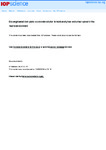Snake Community Ecology And Conservation In Cusuco National Park, Honduras
| dc.contributor.supervisor | Green, Stephen | |
| dc.contributor.author | Lonsdale, George | |
| dc.contributor.other | School of Biological and Marine Sciences | en_US |
| dc.date.accessioned | 2022-02-21T10:03:17Z | |
| dc.date.available | 2022-02-21T10:03:17Z | |
| dc.date.issued | 2022 | |
| dc.identifier | 10596194 | en_US |
| dc.identifier.uri | http://hdl.handle.net/10026.1/18831 | |
| dc.description.abstract |
The Mesoamerican biodiversity hotspot is threatened with agriculture related deforestation and global climate change, both of which drive widespread changes in forest composition. As the forests change, so too does the community of animals they can support; of which many reptiles have evolved micro-niches specific to these forests. Studying how these anthropogenic pressures affect the assemblages of animals that can persist there, could be vital in understanding how biodiversity will be affected on a global scale. Cusuco National Park (CNP), Honduras, is one of the most important protected sites worldwide for herpetofauna biodiversity, due to having such a high diversity of endemic herpetofauna. Despite its importance, CNP also represents one of the most threatened ecosystems in Honduras; with vast swathes of even the most protected pristine core zone being deforested and its wildlife already showing response to global climate change. Using an established network of transects throughout CNP, Visual Encounter Surveys were used to monitor the changes in reptile biodiversity over a 13-year study period. A case study was also conducting investigating the spatial ecology and habitat preferences of Bothriechis marchi, the second most detected species, however, one likely that is underrepresented due to its ecology. Diversity, richness, and evenness were found to decrease with elevation, with higher elevations being dominated by a single species, Cerrophidion wilsoni, whose total encounter numbers were higher than the next two species combined. Species accumulation curves for each of the surveying camps, which span the elevation gradient, have not reached asymptote, suggesting the diversity across CNP has not yet fully been described. Richness and functional guild diversity decreased with deforestation. Snake community assemblages ordinated significantly into lowland, intermediate and higher elevation communities, suggesting elevation is closely linked to snake species assemblage. Radio telemetered snakes spent most of their time out of visually attainable range. Bothriechis marchi spend most of their time, stationary, in the canopy, at heights over 17 m, in closed canopy, moist broadleaf forests that are associated with rivers. One Atropoides mexicanus spent most of its time out of visually attainable range inside a log, undergoing ecdysis. Temperatures did not differ significantly between the log and surroundings indicating shedding sites perform a protective role for this species during a period of heightened vulnerability, rather than a thermoregulatory one. | en_US |
| dc.language.iso | en | |
| dc.publisher | University of Plymouth | |
| dc.rights | CC0 1.0 Universal | * |
| dc.rights.uri | http://creativecommons.org/publicdomain/zero/1.0/ | * |
| dc.subject | Pit Vipers | en_US |
| dc.subject | Ecology | en_US |
| dc.subject | Spatial Ecology | en_US |
| dc.subject | Community Ecology | en_US |
| dc.subject | Cloud Forest | en_US |
| dc.subject | Central America | en_US |
| dc.subject | Radio-telemetry | en_US |
| dc.subject | Snake Ecology | en_US |
| dc.subject.classification | ResM | en_US |
| dc.title | Snake Community Ecology And Conservation In Cusuco National Park, Honduras | en_US |
| dc.type | Thesis | |
| plymouth.version | publishable | en_US |
| dc.identifier.doi | http://dx.doi.org/10.24382/780 | |
| dc.identifier.doi | http://dx.doi.org/10.24382/780 | |
| dc.rights.embargoperiod | No embargo | en_US |
| dc.type.qualification | Masters | en_US |
| rioxxterms.version | NA |
Files in this item
This item appears in the following Collection(s)
-
01 Research Theses Main Collection
Research Theses Main





